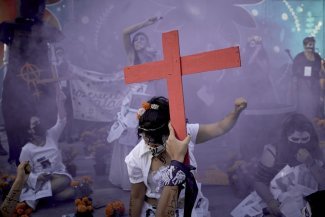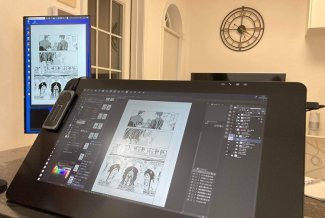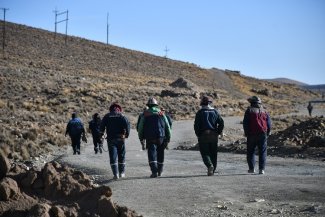

“Anon, who wrote so many poems without signing them, was often a woman,” wrote Virginia Woolf in A Room of One’s Own. It is a sentence that is often misquoted as: “For most of history, Anonymous was a woman.”
The British writer intended to convey that women have been grossly under-represented in both history and the arts, despite making up half of the world’s population.
For decades, female characters in cinema and television were reduced to simple auxiliaries of their male counterparts, their characters often revolving entirely around the drama of men.
This is hardly breaking news. A comic strip by Alison Bechdel called Dykes to watch out for first introduced the ‘Bechdel Test’ in 1985. A movie passes the Bechdel Test when there are at least two female characters talking to each other about a subject other than a male character.
Interestingly enough, the website bechdeltest.com measured 7513 movies and found that more than 40 per cent do not manage to satisfy the criteria to pass the test.
Star Wars is not an ordinary sci-fi movie and its cultural significance cannot be understated. Virtually everyone has heard of it, whether they are a fan or not. This is no mere coincidence. In 1977, George Lucas, an aspiring young director, bet everything on one film, a space opera called Episode IV - A New Hope, which was rejected by every film studio he pitched it to, except the nearly bankrupt 20th Century Fox.
Lucas’ space epic became an instant success due to its engaging characters, interesting plot and masterful use of pioneering special effects techniques, restoring financial viability to Fox and ensuring additional films for the franchise.
By the time the original trilogy was complete, Star Wars had become a cultural phenomenon. It had introduced a number of terms in everyday language such as “May the Force be with you”, popularised a genre of films considered fringe, and influenced a great number of films after it.
Its cultural legacy ran so deep that Disney bought Lucasfilm for US$4 billion in 2012, despite the commercially successful yet critically panned prequel trilogy made by Lucas in the early 2000s.
Intending to launch the franchise anew, Disney tasked movie director J.J. Abrams with creating a film that would match the expectations of millions of fans worldwide. Abrams, recognising that Star Wars and the science fiction genre primarily target male audiences, sought to change this by introducing a female lead character in the first new film The Force Awakens, in 2015.
Is the Galaxy a “boys’ thing”?
How has Star Wars fared over the decades in terms of gender balance? Do the movies pay equal attention to male and female characters, or is this galaxy “Far, Far Away” not nearly far enough to escape Hollywood’s chronic prejudice against female characters?
We analysed every script in the Star Wars series up to The Force Awakens, excluding spin-offs, to find out how often women were included in each movie compared to men, and even robots.
In order to perform this analysis, we found the scripts for every movie from a website called IMSDB and analysed every Star Wars movie. We then separated the dialogue from the screen directions. This allowed us to aggregate the characters and the number of words they said. Then, we found the amount of times the words “He” and “She” were mentioned in the screen directions, which gave us an idea of how often a female character was involved in an action sequence.
To associate gender to a character, we went to IMDB, checked for the character’s name, and if there was a match, we gave them a gender based on the actor’s gender.
For aliens, we assigned them a gender based on the actor’s gender. If that didn’t work, for example, if the character’s name was not found in IMDB, we looked within the script to add a gender. This was the most challenging part of the process and we excluded characters whose gender we could not identify.
We summarised our results in these graphs and came to a number of conclusions.
Disney’s ongoing efforts to include strong female lead characters has positioned Rey (Daisy Ridley), a female Jedi, as the main character in their newest Star Wars trilogy.
Despite that, in every Star Wars movie so far (excluding the latest film The Last Jedi), male characters had by far the most lines. According to our research, this is particularly true in the originals, which were typically the best-rated movies by critics and fans.
The inclusion of female characters in those movies was so rare that even robots (a.k.a. droids) had more dialogue than the female characters. In fact, in A New Hope C-3PO, who was the only droid to speak in the movie, held 13 per cent of the dialogue, while all female characters combined only had 6 per cent of the dialogue. Men dominated the rest.
In The Empire Strikes Back and Return of the Jedi, female characters gained a bigger proportion of the dialogue, but that is primarily due to Leia gaining a bigger role. In those movies, only two female characters said any words, and it was again, a lower proportion than the robot characters such as C-3PO.
Female characters only started gaining more dialogue than the droids in the prequels, but it still wasn’t near to the amount of dialogue given to male characters.
Attack of the Clones : bad reviews, but better on the gender side
The best performing movie, in terms of female dialogue, was Attack of the Clones where female characters had 30 per cent of the dialogue. It even outperformed The Force Awakens, where women spoke 25 per cent of the time even though The Force Awakens was supposed to be more “female friendly”.
Attack of the Clones also had the greatest number of female characters with dialogue out of any Star Wars movie, with 11 female characters speaking. In addition, it was the only movie where a female character had the most words spoken. According to our analysis, Padme said 2,343 words, which was more than Anakin or Obi-Wan.
That said, this is only examining the dialogue. A movie such as Attack of the Clones had much more dialogue and was much slower, and less action-packed, than The Force Awakens. Therefore, another way we measured the gender gap was by examining the amounts of time “He” and “She” were written in the screen directions, which often involve action sequences.
This is where the The Force Awakens truly stands out. It is the only movie, where “She” was written more times than “He”. This makes a lot of sense considering the main character of the movie was Rey, a female character. In every other movie, the female characters were complementary to the male Jedi hero.
This was a nice role reversal and a breath of fresh air, which the series desperately needed after the male-dominated prequels. It will also be interesting to see, how other movies such as the new The Last Jedi movie compares, as it has introduced two additional female characters with big roles in Rose Tico (Kelly Marie Tran) and Vice Admiral Holdo (Laura Dern).
Star Wars has moved the needle in terms of male and female roles but only marginally. Women finally overtook droids, yet the differences are still very stark in modern films such as The Force Awakens.
Despite the efforts made by Disney and J.J. Abrams to boost gender balance in Star Wars, the end product still favours male characters, in terms of dialogue and the number of characters on screen.
Of course, all cultural shifts take time, and so we conclude that this season’s Star Wars still represents an important shift. Despite male characters still receiving more attention, there seems to be a genuine pattern of improvement, which could have spill-over effects for the entire sci-fi genre.








